Chronic Lymphocytic Leukemia (CLL) Essay: Prognosis and Treatment
VerifiedAdded on 2023/06/07
|6
|1475
|62
Essay
AI Summary
This essay examines Chronic Lymphocytic Leukemia (CLL), focusing on its prognosis and various treatment approaches. The essay highlights the favorable five-year survival rate and identifies key biochemical and clinical risk factors, such as CD38 and del13q14, that influence survival rates. It also explores treatment strategies, including chemotherapy regimens like FC, FR, FCR, and CHOP, as well as bone marrow transplantation for younger patients. The essay delves into the mechanisms of action of drugs like fludarabine and cyclophosphamide and discusses targeted therapies using alemtuzumab, ibrutinib, and idelalisib. Additionally, the essay mentions that men are more likely to develop CLL and that family history is also a risk factor.

Running head: ESSAY
Chronic Lymphoblastic Leukaemia (CLL)
Name of the Student
Name of the University
Author Note
Chronic Lymphoblastic Leukaemia (CLL)
Name of the Student
Name of the University
Author Note
Paraphrase This Document
Need a fresh take? Get an instant paraphrase of this document with our AI Paraphraser
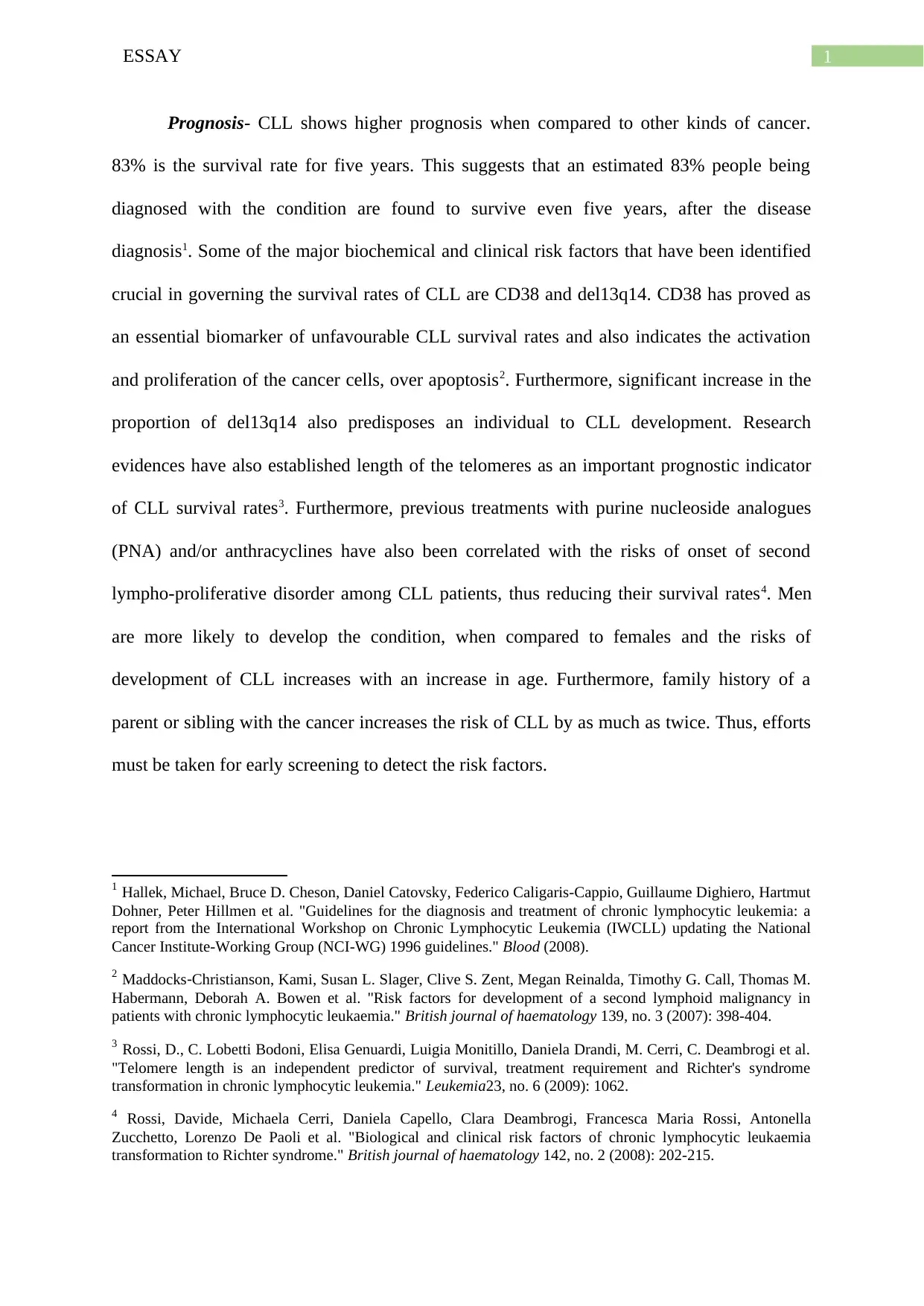
1ESSAY
Prognosis- CLL shows higher prognosis when compared to other kinds of cancer.
83% is the survival rate for five years. This suggests that an estimated 83% people being
diagnosed with the condition are found to survive even five years, after the disease
diagnosis1. Some of the major biochemical and clinical risk factors that have been identified
crucial in governing the survival rates of CLL are CD38 and del13q14. CD38 has proved as
an essential biomarker of unfavourable CLL survival rates and also indicates the activation
and proliferation of the cancer cells, over apoptosis2. Furthermore, significant increase in the
proportion of del13q14 also predisposes an individual to CLL development. Research
evidences have also established length of the telomeres as an important prognostic indicator
of CLL survival rates3. Furthermore, previous treatments with purine nucleoside analogues
(PNA) and/or anthracyclines have also been correlated with the risks of onset of second
lympho-proliferative disorder among CLL patients, thus reducing their survival rates4. Men
are more likely to develop the condition, when compared to females and the risks of
development of CLL increases with an increase in age. Furthermore, family history of a
parent or sibling with the cancer increases the risk of CLL by as much as twice. Thus, efforts
must be taken for early screening to detect the risk factors.
1 Hallek, Michael, Bruce D. Cheson, Daniel Catovsky, Federico Caligaris-Cappio, Guillaume Dighiero, Hartmut
Dohner, Peter Hillmen et al. "Guidelines for the diagnosis and treatment of chronic lymphocytic leukemia: a
report from the International Workshop on Chronic Lymphocytic Leukemia (IWCLL) updating the National
Cancer Institute-Working Group (NCI-WG) 1996 guidelines." Blood (2008).
2 Maddocks‐Christianson, Kami, Susan L. Slager, Clive S. Zent, Megan Reinalda, Timothy G. Call, Thomas M.
Habermann, Deborah A. Bowen et al. "Risk factors for development of a second lymphoid malignancy in
patients with chronic lymphocytic leukaemia." British journal of haematology 139, no. 3 (2007): 398-404.
3 Rossi, D., C. Lobetti Bodoni, Elisa Genuardi, Luigia Monitillo, Daniela Drandi, M. Cerri, C. Deambrogi et al.
"Telomere length is an independent predictor of survival, treatment requirement and Richter's syndrome
transformation in chronic lymphocytic leukemia." Leukemia23, no. 6 (2009): 1062.
4 Rossi, Davide, Michaela Cerri, Daniela Capello, Clara Deambrogi, Francesca Maria Rossi, Antonella
Zucchetto, Lorenzo De Paoli et al. "Biological and clinical risk factors of chronic lymphocytic leukaemia
transformation to Richter syndrome." British journal of haematology 142, no. 2 (2008): 202-215.
Prognosis- CLL shows higher prognosis when compared to other kinds of cancer.
83% is the survival rate for five years. This suggests that an estimated 83% people being
diagnosed with the condition are found to survive even five years, after the disease
diagnosis1. Some of the major biochemical and clinical risk factors that have been identified
crucial in governing the survival rates of CLL are CD38 and del13q14. CD38 has proved as
an essential biomarker of unfavourable CLL survival rates and also indicates the activation
and proliferation of the cancer cells, over apoptosis2. Furthermore, significant increase in the
proportion of del13q14 also predisposes an individual to CLL development. Research
evidences have also established length of the telomeres as an important prognostic indicator
of CLL survival rates3. Furthermore, previous treatments with purine nucleoside analogues
(PNA) and/or anthracyclines have also been correlated with the risks of onset of second
lympho-proliferative disorder among CLL patients, thus reducing their survival rates4. Men
are more likely to develop the condition, when compared to females and the risks of
development of CLL increases with an increase in age. Furthermore, family history of a
parent or sibling with the cancer increases the risk of CLL by as much as twice. Thus, efforts
must be taken for early screening to detect the risk factors.
1 Hallek, Michael, Bruce D. Cheson, Daniel Catovsky, Federico Caligaris-Cappio, Guillaume Dighiero, Hartmut
Dohner, Peter Hillmen et al. "Guidelines for the diagnosis and treatment of chronic lymphocytic leukemia: a
report from the International Workshop on Chronic Lymphocytic Leukemia (IWCLL) updating the National
Cancer Institute-Working Group (NCI-WG) 1996 guidelines." Blood (2008).
2 Maddocks‐Christianson, Kami, Susan L. Slager, Clive S. Zent, Megan Reinalda, Timothy G. Call, Thomas M.
Habermann, Deborah A. Bowen et al. "Risk factors for development of a second lymphoid malignancy in
patients with chronic lymphocytic leukaemia." British journal of haematology 139, no. 3 (2007): 398-404.
3 Rossi, D., C. Lobetti Bodoni, Elisa Genuardi, Luigia Monitillo, Daniela Drandi, M. Cerri, C. Deambrogi et al.
"Telomere length is an independent predictor of survival, treatment requirement and Richter's syndrome
transformation in chronic lymphocytic leukemia." Leukemia23, no. 6 (2009): 1062.
4 Rossi, Davide, Michaela Cerri, Daniela Capello, Clara Deambrogi, Francesca Maria Rossi, Antonella
Zucchetto, Lorenzo De Paoli et al. "Biological and clinical risk factors of chronic lymphocytic leukaemia
transformation to Richter syndrome." British journal of haematology 142, no. 2 (2008): 202-215.
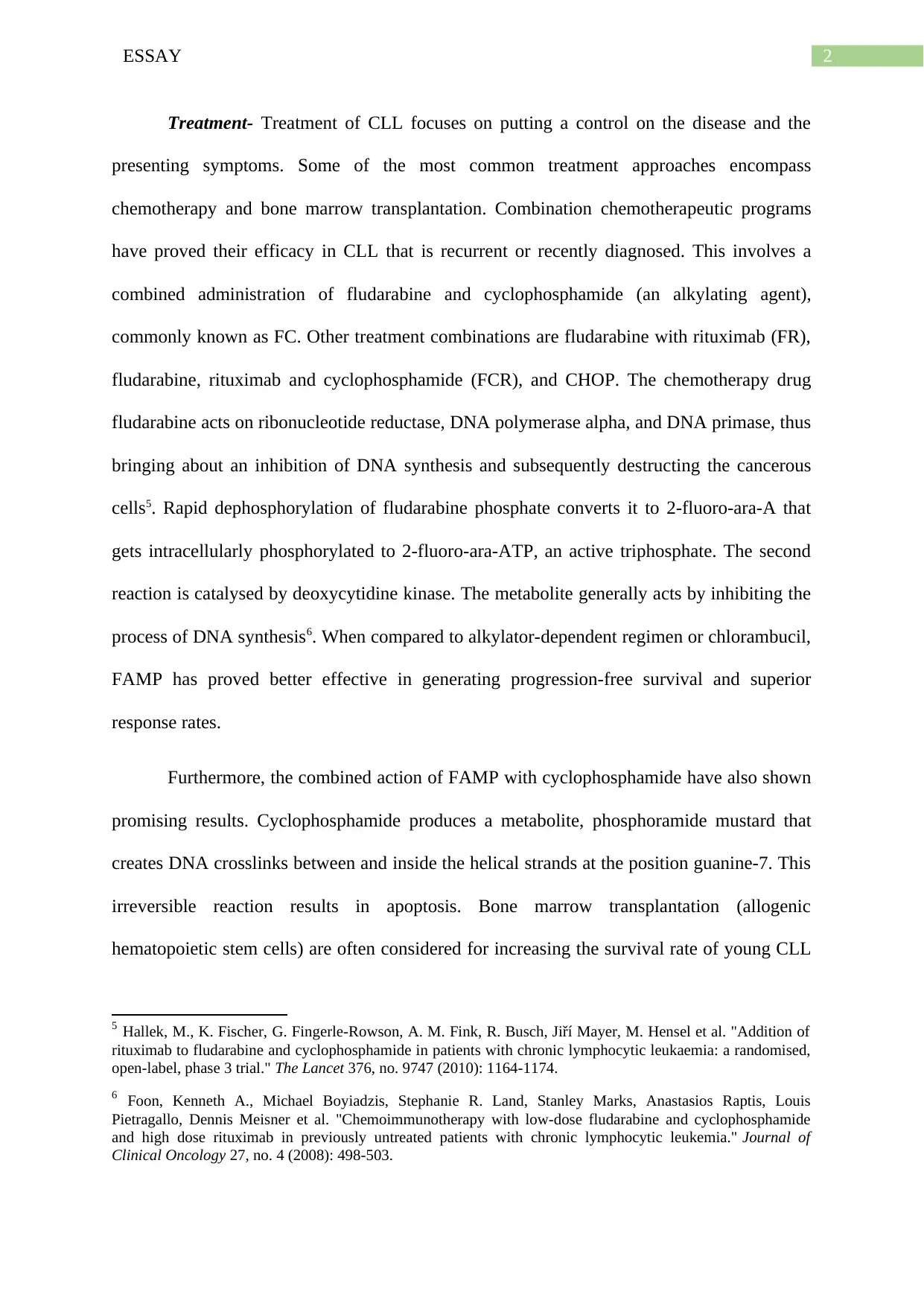
2ESSAY
Treatment- Treatment of CLL focuses on putting a control on the disease and the
presenting symptoms. Some of the most common treatment approaches encompass
chemotherapy and bone marrow transplantation. Combination chemotherapeutic programs
have proved their efficacy in CLL that is recurrent or recently diagnosed. This involves a
combined administration of fludarabine and cyclophosphamide (an alkylating agent),
commonly known as FC. Other treatment combinations are fludarabine with rituximab (FR),
fludarabine, rituximab and cyclophosphamide (FCR), and CHOP. The chemotherapy drug
fludarabine acts on ribonucleotide reductase, DNA polymerase alpha, and DNA primase, thus
bringing about an inhibition of DNA synthesis and subsequently destructing the cancerous
cells5. Rapid dephosphorylation of fludarabine phosphate converts it to 2-fluoro-ara-A that
gets intracellularly phosphorylated to 2-fluoro-ara-ATP, an active triphosphate. The second
reaction is catalysed by deoxycytidine kinase. The metabolite generally acts by inhibiting the
process of DNA synthesis6. When compared to alkylator-dependent regimen or chlorambucil,
FAMP has proved better effective in generating progression-free survival and superior
response rates.
Furthermore, the combined action of FAMP with cyclophosphamide have also shown
promising results. Cyclophosphamide produces a metabolite, phosphoramide mustard that
creates DNA crosslinks between and inside the helical strands at the position guanine-7. This
irreversible reaction results in apoptosis. Bone marrow transplantation (allogenic
hematopoietic stem cells) are often considered for increasing the survival rate of young CLL
5 Hallek, M., K. Fischer, G. Fingerle-Rowson, A. M. Fink, R. Busch, Jiří Mayer, M. Hensel et al. "Addition of
rituximab to fludarabine and cyclophosphamide in patients with chronic lymphocytic leukaemia: a randomised,
open-label, phase 3 trial." The Lancet 376, no. 9747 (2010): 1164-1174.
6 Foon, Kenneth A., Michael Boyiadzis, Stephanie R. Land, Stanley Marks, Anastasios Raptis, Louis
Pietragallo, Dennis Meisner et al. "Chemoimmunotherapy with low-dose fludarabine and cyclophosphamide
and high dose rituximab in previously untreated patients with chronic lymphocytic leukemia." Journal of
Clinical Oncology 27, no. 4 (2008): 498-503.
Treatment- Treatment of CLL focuses on putting a control on the disease and the
presenting symptoms. Some of the most common treatment approaches encompass
chemotherapy and bone marrow transplantation. Combination chemotherapeutic programs
have proved their efficacy in CLL that is recurrent or recently diagnosed. This involves a
combined administration of fludarabine and cyclophosphamide (an alkylating agent),
commonly known as FC. Other treatment combinations are fludarabine with rituximab (FR),
fludarabine, rituximab and cyclophosphamide (FCR), and CHOP. The chemotherapy drug
fludarabine acts on ribonucleotide reductase, DNA polymerase alpha, and DNA primase, thus
bringing about an inhibition of DNA synthesis and subsequently destructing the cancerous
cells5. Rapid dephosphorylation of fludarabine phosphate converts it to 2-fluoro-ara-A that
gets intracellularly phosphorylated to 2-fluoro-ara-ATP, an active triphosphate. The second
reaction is catalysed by deoxycytidine kinase. The metabolite generally acts by inhibiting the
process of DNA synthesis6. When compared to alkylator-dependent regimen or chlorambucil,
FAMP has proved better effective in generating progression-free survival and superior
response rates.
Furthermore, the combined action of FAMP with cyclophosphamide have also shown
promising results. Cyclophosphamide produces a metabolite, phosphoramide mustard that
creates DNA crosslinks between and inside the helical strands at the position guanine-7. This
irreversible reaction results in apoptosis. Bone marrow transplantation (allogenic
hematopoietic stem cells) are often considered for increasing the survival rate of young CLL
5 Hallek, M., K. Fischer, G. Fingerle-Rowson, A. M. Fink, R. Busch, Jiří Mayer, M. Hensel et al. "Addition of
rituximab to fludarabine and cyclophosphamide in patients with chronic lymphocytic leukaemia: a randomised,
open-label, phase 3 trial." The Lancet 376, no. 9747 (2010): 1164-1174.
6 Foon, Kenneth A., Michael Boyiadzis, Stephanie R. Land, Stanley Marks, Anastasios Raptis, Louis
Pietragallo, Dennis Meisner et al. "Chemoimmunotherapy with low-dose fludarabine and cyclophosphamide
and high dose rituximab in previously untreated patients with chronic lymphocytic leukemia." Journal of
Clinical Oncology 27, no. 4 (2008): 498-503.
⊘ This is a preview!⊘
Do you want full access?
Subscribe today to unlock all pages.

Trusted by 1+ million students worldwide
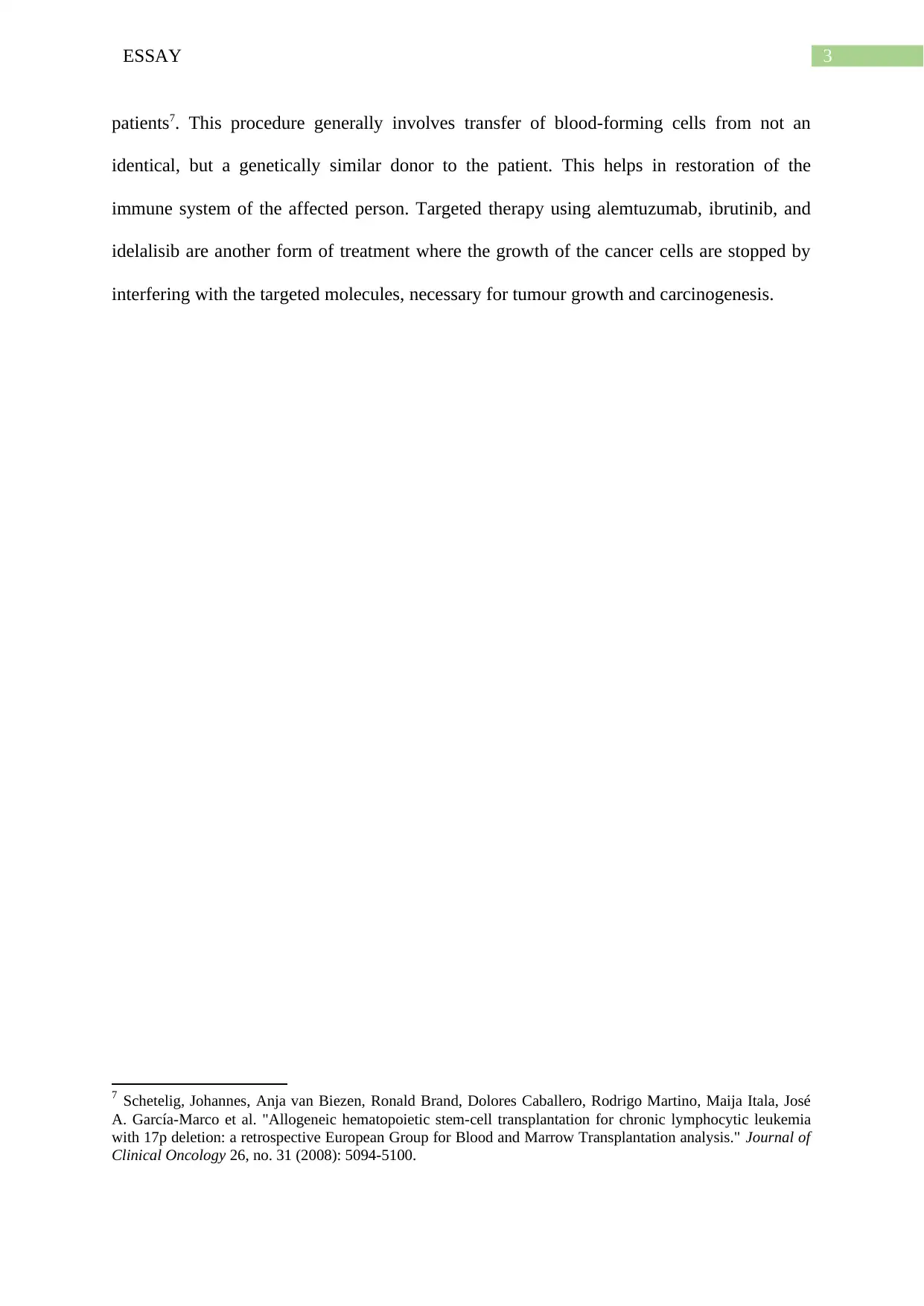
3ESSAY
patients7. This procedure generally involves transfer of blood-forming cells from not an
identical, but a genetically similar donor to the patient. This helps in restoration of the
immune system of the affected person. Targeted therapy using alemtuzumab, ibrutinib, and
idelalisib are another form of treatment where the growth of the cancer cells are stopped by
interfering with the targeted molecules, necessary for tumour growth and carcinogenesis.
7 Schetelig, Johannes, Anja van Biezen, Ronald Brand, Dolores Caballero, Rodrigo Martino, Maija Itala, José
A. García-Marco et al. "Allogeneic hematopoietic stem-cell transplantation for chronic lymphocytic leukemia
with 17p deletion: a retrospective European Group for Blood and Marrow Transplantation analysis." Journal of
Clinical Oncology 26, no. 31 (2008): 5094-5100.
patients7. This procedure generally involves transfer of blood-forming cells from not an
identical, but a genetically similar donor to the patient. This helps in restoration of the
immune system of the affected person. Targeted therapy using alemtuzumab, ibrutinib, and
idelalisib are another form of treatment where the growth of the cancer cells are stopped by
interfering with the targeted molecules, necessary for tumour growth and carcinogenesis.
7 Schetelig, Johannes, Anja van Biezen, Ronald Brand, Dolores Caballero, Rodrigo Martino, Maija Itala, José
A. García-Marco et al. "Allogeneic hematopoietic stem-cell transplantation for chronic lymphocytic leukemia
with 17p deletion: a retrospective European Group for Blood and Marrow Transplantation analysis." Journal of
Clinical Oncology 26, no. 31 (2008): 5094-5100.
Paraphrase This Document
Need a fresh take? Get an instant paraphrase of this document with our AI Paraphraser
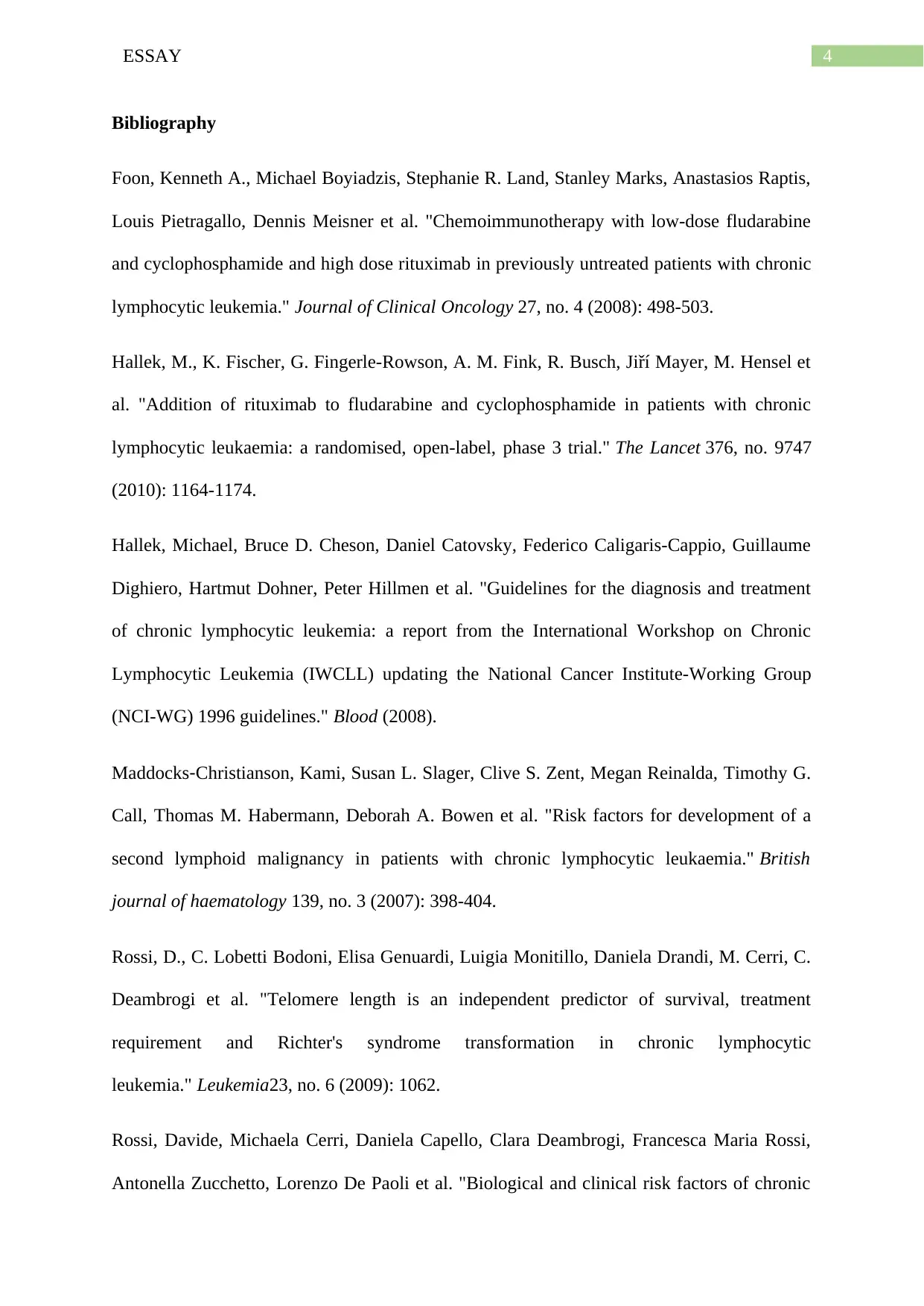
4ESSAY
Bibliography
Foon, Kenneth A., Michael Boyiadzis, Stephanie R. Land, Stanley Marks, Anastasios Raptis,
Louis Pietragallo, Dennis Meisner et al. "Chemoimmunotherapy with low-dose fludarabine
and cyclophosphamide and high dose rituximab in previously untreated patients with chronic
lymphocytic leukemia." Journal of Clinical Oncology 27, no. 4 (2008): 498-503.
Hallek, M., K. Fischer, G. Fingerle-Rowson, A. M. Fink, R. Busch, Jiří Mayer, M. Hensel et
al. "Addition of rituximab to fludarabine and cyclophosphamide in patients with chronic
lymphocytic leukaemia: a randomised, open-label, phase 3 trial." The Lancet 376, no. 9747
(2010): 1164-1174.
Hallek, Michael, Bruce D. Cheson, Daniel Catovsky, Federico Caligaris-Cappio, Guillaume
Dighiero, Hartmut Dohner, Peter Hillmen et al. "Guidelines for the diagnosis and treatment
of chronic lymphocytic leukemia: a report from the International Workshop on Chronic
Lymphocytic Leukemia (IWCLL) updating the National Cancer Institute-Working Group
(NCI-WG) 1996 guidelines." Blood (2008).
Maddocks‐Christianson, Kami, Susan L. Slager, Clive S. Zent, Megan Reinalda, Timothy G.
Call, Thomas M. Habermann, Deborah A. Bowen et al. "Risk factors for development of a
second lymphoid malignancy in patients with chronic lymphocytic leukaemia." British
journal of haematology 139, no. 3 (2007): 398-404.
Rossi, D., C. Lobetti Bodoni, Elisa Genuardi, Luigia Monitillo, Daniela Drandi, M. Cerri, C.
Deambrogi et al. "Telomere length is an independent predictor of survival, treatment
requirement and Richter's syndrome transformation in chronic lymphocytic
leukemia." Leukemia23, no. 6 (2009): 1062.
Rossi, Davide, Michaela Cerri, Daniela Capello, Clara Deambrogi, Francesca Maria Rossi,
Antonella Zucchetto, Lorenzo De Paoli et al. "Biological and clinical risk factors of chronic
Bibliography
Foon, Kenneth A., Michael Boyiadzis, Stephanie R. Land, Stanley Marks, Anastasios Raptis,
Louis Pietragallo, Dennis Meisner et al. "Chemoimmunotherapy with low-dose fludarabine
and cyclophosphamide and high dose rituximab in previously untreated patients with chronic
lymphocytic leukemia." Journal of Clinical Oncology 27, no. 4 (2008): 498-503.
Hallek, M., K. Fischer, G. Fingerle-Rowson, A. M. Fink, R. Busch, Jiří Mayer, M. Hensel et
al. "Addition of rituximab to fludarabine and cyclophosphamide in patients with chronic
lymphocytic leukaemia: a randomised, open-label, phase 3 trial." The Lancet 376, no. 9747
(2010): 1164-1174.
Hallek, Michael, Bruce D. Cheson, Daniel Catovsky, Federico Caligaris-Cappio, Guillaume
Dighiero, Hartmut Dohner, Peter Hillmen et al. "Guidelines for the diagnosis and treatment
of chronic lymphocytic leukemia: a report from the International Workshop on Chronic
Lymphocytic Leukemia (IWCLL) updating the National Cancer Institute-Working Group
(NCI-WG) 1996 guidelines." Blood (2008).
Maddocks‐Christianson, Kami, Susan L. Slager, Clive S. Zent, Megan Reinalda, Timothy G.
Call, Thomas M. Habermann, Deborah A. Bowen et al. "Risk factors for development of a
second lymphoid malignancy in patients with chronic lymphocytic leukaemia." British
journal of haematology 139, no. 3 (2007): 398-404.
Rossi, D., C. Lobetti Bodoni, Elisa Genuardi, Luigia Monitillo, Daniela Drandi, M. Cerri, C.
Deambrogi et al. "Telomere length is an independent predictor of survival, treatment
requirement and Richter's syndrome transformation in chronic lymphocytic
leukemia." Leukemia23, no. 6 (2009): 1062.
Rossi, Davide, Michaela Cerri, Daniela Capello, Clara Deambrogi, Francesca Maria Rossi,
Antonella Zucchetto, Lorenzo De Paoli et al. "Biological and clinical risk factors of chronic
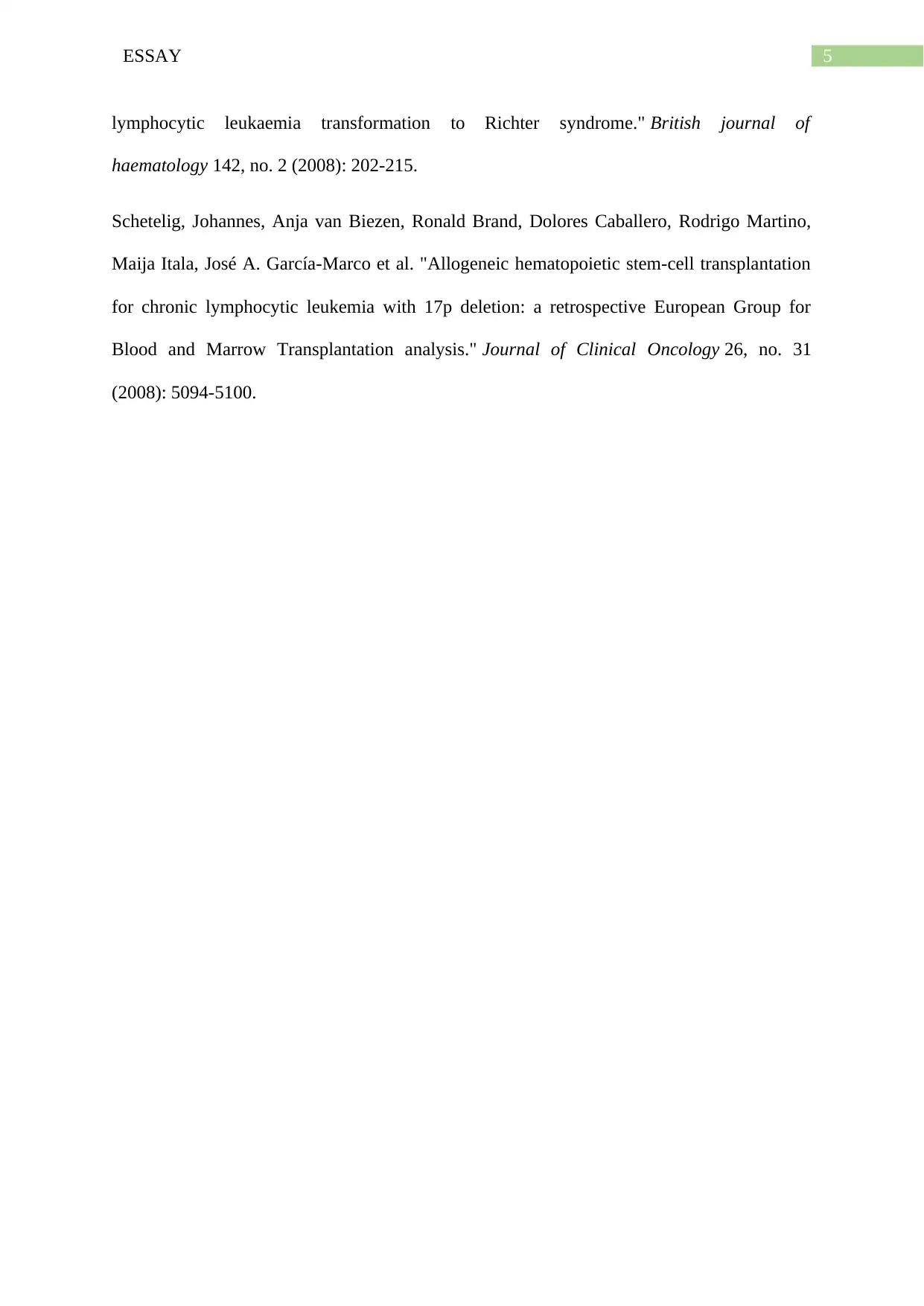
5ESSAY
lymphocytic leukaemia transformation to Richter syndrome." British journal of
haematology 142, no. 2 (2008): 202-215.
Schetelig, Johannes, Anja van Biezen, Ronald Brand, Dolores Caballero, Rodrigo Martino,
Maija Itala, José A. García-Marco et al. "Allogeneic hematopoietic stem-cell transplantation
for chronic lymphocytic leukemia with 17p deletion: a retrospective European Group for
Blood and Marrow Transplantation analysis." Journal of Clinical Oncology 26, no. 31
(2008): 5094-5100.
lymphocytic leukaemia transformation to Richter syndrome." British journal of
haematology 142, no. 2 (2008): 202-215.
Schetelig, Johannes, Anja van Biezen, Ronald Brand, Dolores Caballero, Rodrigo Martino,
Maija Itala, José A. García-Marco et al. "Allogeneic hematopoietic stem-cell transplantation
for chronic lymphocytic leukemia with 17p deletion: a retrospective European Group for
Blood and Marrow Transplantation analysis." Journal of Clinical Oncology 26, no. 31
(2008): 5094-5100.
⊘ This is a preview!⊘
Do you want full access?
Subscribe today to unlock all pages.

Trusted by 1+ million students worldwide
1 out of 6
Your All-in-One AI-Powered Toolkit for Academic Success.
+13062052269
info@desklib.com
Available 24*7 on WhatsApp / Email
![[object Object]](/_next/static/media/star-bottom.7253800d.svg)
Unlock your academic potential
Copyright © 2020–2026 A2Z Services. All Rights Reserved. Developed and managed by ZUCOL.